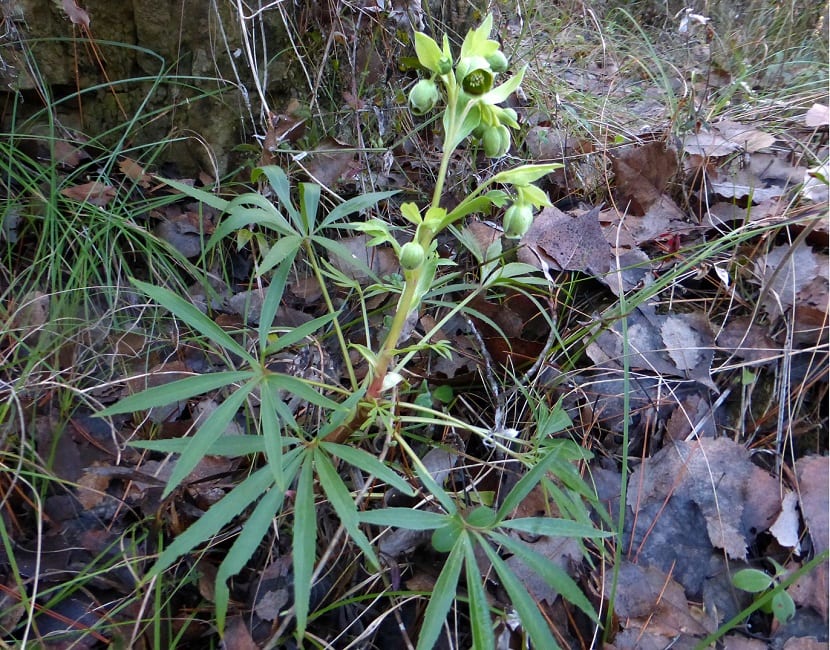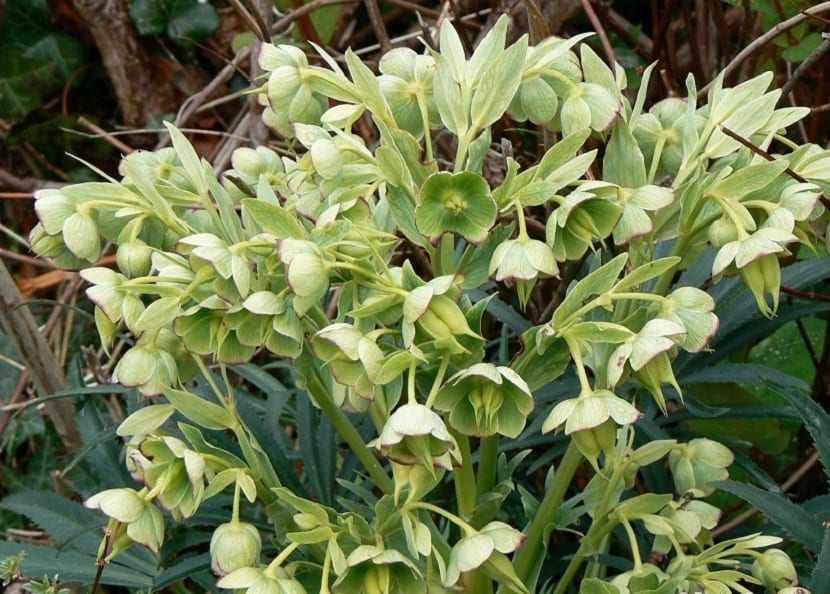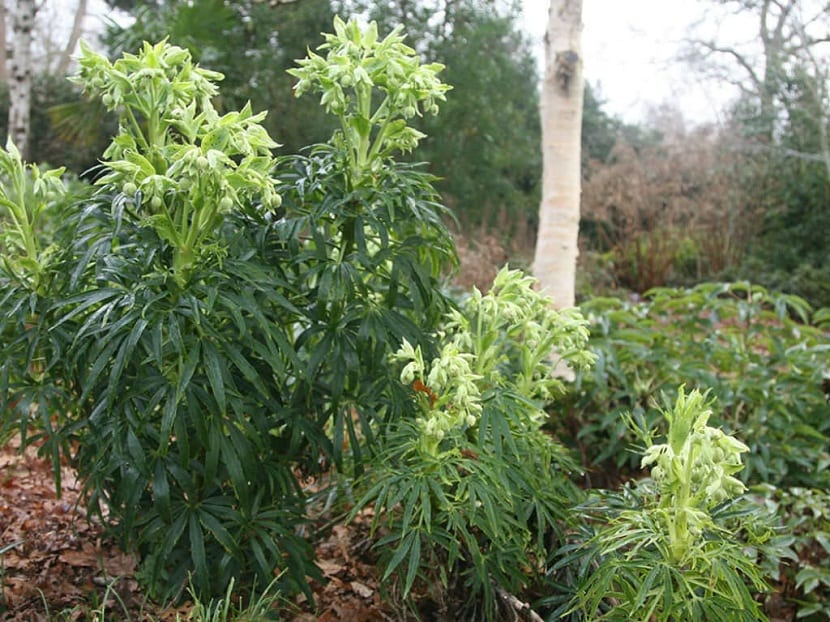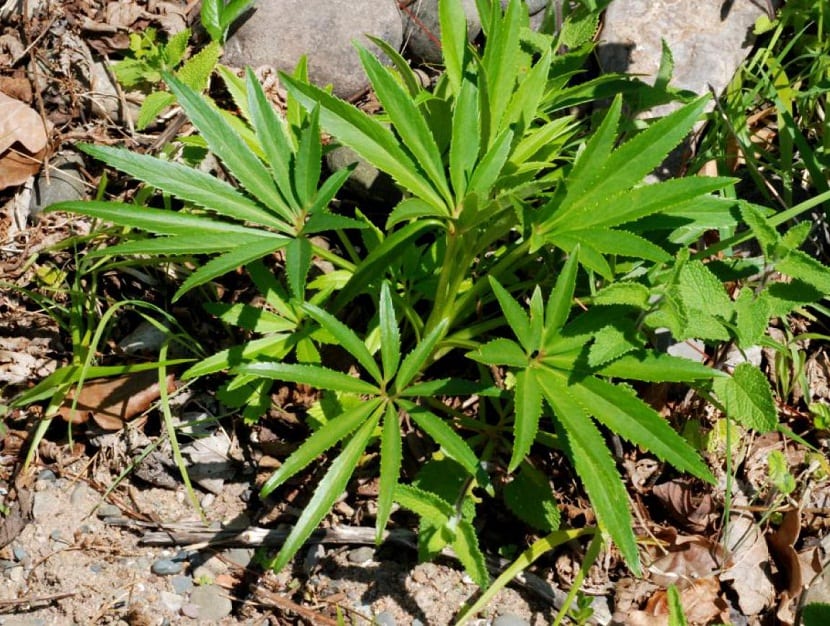
El Helleborus fetidus it is a plant with an unpleasant smell that belongs to the family RanunculaeaeKnown as fetid hellebore or crossbow grass. This hellebore owes its name to the fact that its leaves emit an unpleasant smell. Despite their toxicity, these plants have been known since ancient times due to their medicinal properties.
Origin and habitat

This species is native to the central and southern regions of Europe, it can be seen from Great Britain to Greece and part of Asia Minor. It is also present throughout the Iberian Peninsula. It grows wild on the margins of forests, in dense and stony places up to altitudes of approximately 1000 meters above sea level.
In the gardens it is a tolerant plant to the variety of existing conditionsHowever, it takes time to settle. Once this plant is sufficiently ingrained, its extraordinary foliage can be enjoyed.
Features Helleborus fetidus
El Helleborus fetidus It is a herbaceous plant with evergreen foliage, its height can reach up to 80 with an approximate diameter of one meter. From succulent stem, woody at its base, crawls and then is erect.
With quite lucid leaves, this species has the peculiarity that its resistant leaves are found divided into leaflets arranged irregularly, narrow, lanceolate and serrated. The herbaceous portions of the plant are usually dried annually and only its woody parts are kept alive and sometimes its leaves as well.It is a decorative ornamental species, thanks to its impressive foliage and attractive flowers.
It usually blooms from January to April, so it is not uncommon to see it covered with snow. Generally, the flowers that fall have a cup shape and the florets appear at the beginning of spring or in the middle of winter, their flowers have a yellowish hue. Its flowers frequently have five sepals with purple margins.These have numerous stamens and up to ten honey-producing glands that make it prone to bees and other critters.
Each of its flowers has a producing capacity of up to five follicles. Its fruits are similar to the pods of peas. Its green fruit is elongated and inside it contains numerous seeds that are released when they open. Its seeds are very attractive to ants, which in turn serve to disperse the helleborus. In short, it is a plant that stands out for its size and its formidable leaves and flowers.
Cultivation and care
It is a herbaceous that is usually planted in gardens for its magnificent evergreen foliage and the immense amount of bell-shaped flowers that remain even in late winter. This is a plant that grows in fertile and humid forestsPrefers well-drained, calcic soils, rich in organic substances and located in the shade. It is a species that tolerates times of drought and can also resist low temperatures down to -25 ° C.

The spread of Helleborus fetidus It is carried out by means of basal cuttings of seedlings or also with young seeds, which are fertile for the multiplication of the species, if the conditions are suitable. The division procedure does not apply to this plant. He Hellebore it is relatively melliferous and the nectar is desirable only available to bees.
For its cultivation it is recommended to sow its seeds when they are ripe in a cold environment. Plant the seeds at the beginning of the year, these usually germinate during the fall until spring. Nevertheless, germination can take approximately 18 months, so you need to have a little patience. Its flowers can only be enjoyed after 2 or 3 years, counted from the planting of the seed.
Among the species of the genus, it is perhaps the one that best tolerates the conditions of exposure to the sun and long droughts. Individuals rooted in gardens are often directly seeded. The opening or dehiscence occurs at the upper end of the follicles. The seeds contain nutritious substances of glucose, fructose, fats and vitamins C, which are an important source of nutrients for ants.
Diseases and parasites
El Helleborus fetidus and like most plants of its genus, they are resistant to disease and pests. Nevertheless, in recent years a viral disease has become present that attacks the genus Hellebore, known as the Black Death of Helleborus. Some of the symptoms of this rare disease are a delay in growth and the appearance of black spots on the leaves.
The plant is prone to fungal attack because this species prefers humid and shady areas where air circulation is quite limited. The most common fungal diseases are leaf spot and mold. Mildew is another fungal or fungal disease that spreads in different parts of the plant.
Signs of it are a powdery whitish layer that forms on stems, leaves, and flowers, turning yellow on foliage as the disease worsens. But not all is bad news, there are natural remedies to eliminate the mushroom.
In relation to fungal diseases, these are difficult to treat, so it is best to take all possible preventive measures to control its appearance. One of those measures is to try to water as little as possible and limit yourself only to watering the root area, avoiding splashing its leaves.
It is also important to keep the plants separated from each other, to improve air circulation. The crowded, dark and humid conditions favor the appearance of fungal diseases. Likewise, the area must be kept free of debris. Preventive fungicides can be effective, as long as they are used early during the growth period of the plant to avoid the possible appearance of infections caused by fungi.
Uses

The different parts of the Helleborus fetidus they are slightly toxic. Its ingestion can cause vomiting, but not tremens delusions as people tend to believe. The leaves serve as a purgative, but can produce a reaction that often causes sneezing. Despite its toxicity, its ingestion is not fatal in any case. Some argue that it has applications in veterinary medicine, where it has been used as a vermifuge.
Recommended collect its roots during the fall, after drying them to be used in the treatment of some diseases such as arterial hypertension where it is applied to lower high blood pressure. Its medicinal properties are similar to those of Hellborus niger. It is used as a stimulant of the heart rhythm in elderly patients, although at present this treatment is practically in disuse.
Its root serves as anthelmintic, powerful purgative, diuretic and vomiting stimulant and pain reliever. It has also been used to treat dropsy, amenorrhea and some disorders of the nervous system, but the accompaniment of a medical professional is recommended for its use. It is also used to control pests, such as fleas and lice.